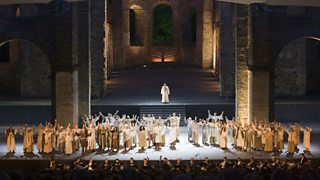
- #During which style period did opera develop how to#
- #During which style period did opera develop full#
Now that tickets were being sold, the pressure to produce next-level productions was on. Soon, Italian opera had taken Europe by storm and the opera house was not only a visually spectacular place to see and be seen but a feast for the ears as well. By the end of the century, Venice had built more than a dozen. When Venice’s Teatro San Cassiano opened to the public in 1637, an appetite for opera was ignited in the masses.

But that began to shift during the Baroque period (1600–1750), with the advent of the opera house. Even though only six of Monteverdi’s operas still exist, it is clear why his contributions earned him the title “Father of opera.” Monteverdi’s L’Orfeo – Teatro Real Opera, now available to (almost) everyoneĪnother reason early opera grew in popularity is that it was presented exclusively to the cultural change-makers, i.e the rich. Monteverdi bent the rules of polyphony well beyond what previous composers (like Palestrina) had previously considered sacrosanct. And it worked so well that it is still performed today.
#During which style period did opera develop full#
L’Orfeo was the first attempt to combine the full resources of music and art, which became the burgeoning genre of opera. It wasn’t until Claudio Monteverdi (1567–1643) gave us La favola d’Orfeo, his take on the Orpheus story, in 1607 that opera started taking the shape we all know and love. Peri’s operas, though novel, were still a bit tedious and disjointed. Peri’s wealthy patrons demanded a sunnier ending, which soon became a common practice in all operatic writing. This tragic ending, however, would not do. He fails, and she is forever trapped in the Underworld. While there is no surviving manuscript, we do have Peri’s Eurydice, which premiered at a nobleman’s wedding in 1600.Įurydice, based on the Greek legend of Orpheus, tells the story of his descent to the underworld to bring his dead bride back to the living world. Enter Jacopo Peri (1561–1633), who composed what many consider to be the first opera, Dafne (1597). Unfortunately, not one of the Camerata members could pull off anything worth producing. To that end, the Camerata was inspired to recreate Greek tragedy by setting drama to music, which they called “ dramma per musica. They declared a war on polyphony, which refers generally to music consisting of two or more distinct melodic lines performed simultaneously. The Camerata unanimously believed that for every phrase of poetry, the lyrics, there could only be one unique melody that perfectly expressed it. They were called the Florentine Camerata.
#During which style period did opera develop how to#
How did Italian opera start?Īround the late 1500s (toward the end of the Renaissance), in Florence, Italy, an all-male who’s-who of intellectual and artistic society gathered to discuss how to improve popular music of the day. In short, Italian opera combines recitative (a type of speak- singing that imitates the rhythm and delivery of ordinary speech to move the plot forward) with arias, duets, trios, etc. But let’s be clear, we’re talking about the Italian opera style here, which can be written in any language. The rich (and juicy!) history behind how Italian opera came to dominate the genre goes hand in hand with why. S.482-2015.The simplest reason for Italian opera’s 400-year reign is that it’s an exquisite way to express pure emotion and to tell a layered, multisensory story.

Poster for Madam Butterfly, Poligrafici Luigi Parma, 1974, Italy. In Britain, Benjamin Britten composed both 'traditional' operas like Peter Grimes (1945) and pared-back 'chamber operas' such as The Rape of Lucretia (1946) and The Turn of the Screw (1954). In Austria, Alban Berg wrote the atonal Wozzeck in 1925, while Kurt Weill created his jazz-inspired work, The Threepenny Opera, in 1928. As the century progressed, the general trends of opera became even more fractured, under the influence of the Avant Garde movement. In France, Debussy explored poetic and evocative melody, composing Pelleas and Melisande, (1902), while in Germany, Strauss was dissonant and intentionally shocking in his approach, with extreme subject matter such as Salome, with its erotic 'Dance of the Seven Veils', in 1905. In Italy, Puccini recreated 19th century romanticism with well-loved operas such as Tosca (1900), Madam Butterfly (1904), and Turandot (1926). The 20th century saw a more individualistic approach.


 0 kommentar(er)
0 kommentar(er)
